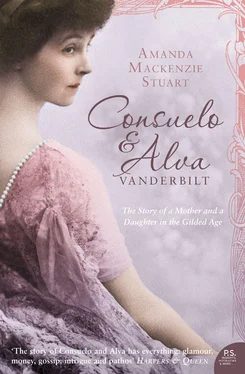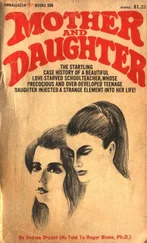Meanwhile Town Topics reported that Oliver Belmont would also be entertaining the Duke when he arrived in Newport, and that he was planning his own splendid ball to take place shortly after the one being given by Alva. So many people had a vested interest in the success of the Duke’s visit that eighteen-year-old Consuelo must indeed have felt that the forces ranged against her were overpowering and that the whole situation was too difficult to fight. The only person to whom she confided her fears was her English governess, Miss Harper, of whom she was very fond. In Edith Wharton’s novel The Buccaneers , the governess sacrifices her own happiness to secure the happiness of her charge. Miss Harper chose a more pragmatic approach. ‘How wisely she spoke of the future awaiting me in her country, of the opportunities for usefulness and social service I would find there, of the happiness a life lived for others can bring. And in such gentle appeals to my better nature she slowly swung me from contemplation of a purely personal nature to a higher idealism.’ 112 It was just as well for the news soon arrived at Marble House that the Duke was on his way to New York aboard the Campania and would be in Newport in just a few days.
* In The Buccaneers Edith Wharton writes: ‘A good many hours of Mrs St George’s days were spent in mentally cataloguing and appraising the physical attributes of the young ladies in whose company her daughters trailed up and down the verandas … As regards hair and complexion, there could be no doubt; Virginia, all rose and pearl, with sheaves of full fair hair heaped above her low forehead, was as pure and luminous as an apple-blossom. But Lizzy’s waist was certainly at least an inch smaller (some said two),’ pp. 4–5, p. 6.
** They were: Maud Burke to Sir Bache Cunard; Mary Leiter to George Curzon; Josephine Chamberlain to the 1st Baron Scarisbrick; Lily Hammersley to Lord William Beresford; Elizabeth LaRoche to Sir Howland Roberts; Leonora Van Roberts to the 7th Earl of Tankerville; Pauline Whitney to Almeric Paget; Cora Rogers to Baron Fairhaven of Lode; and Consuelo Vanderbilt to the 9th Duke of Marlborough.
THE DUKE OF MARLBOROUGH was not the star passenger as he left Liverpool on the Cunard steamer Campania on Saturday 16 August 1895. This slot was reserved for Keir Hardie, leader of Britain’s emerging Independent Labour Party who was on his way to the United States for a lecture tour, and who was seen out of the harbour by waving supporters in a tug boat, The Toiler, complete with bunting, a band, and fluttering socialist mottoes.
Keir Hardie noticed the ‘haughty aristocrat’ immediately he boarded the Campania but refused to be intimidated. ‘There are dukes and archbishops and bishops and State Senators on board; but the I.L.P. passengers were the only ones who could command a crowded tug boat by way of a farewell,’ he wrote in tones of satisfaction a week later. 1 One of the ship’s waiters told Keir Hardie that the Duke of Marlborough had been most interested in his presence, though he did not attend any of Keir Hardie’s impromptu on-board talks about socialism, where Hardie drew on the relationship between the Campania ’s cabin accommodation and the British class structure to illustrate his point. 2
When they disembarked in New York on Friday 23 August, however, it was the Duke who was greeted by the New York press, in a manner for which he was wholly unprepared. He was followed to the Waldorf; he was observed eating breakfast at 10 o’clock; he was joined by Captain A. H. Lee, a fellow passenger on the Campania ; he took a stroll down Fifth Avenue; and he was called on by Creighton Webb (the same old roué who had tried to marry Cousin Adele). He then travelled in a reserved seat in a parlour car on the 5 o’clock train to Newport on the following day, Saturday. ‘Look-outs from some of the great housetops on the Cliffs are already watching for his Grace’s arrival,’ said the New York Herald ; ‘and should he come he may expect a charge such as his famous ancestor, John Churchill, never met.’ 3
The charge soon came. The news that the Duke had been seen with the Vanderbilts at Trinity Church in Newport on Sunday morning spread fast. That afternoon Alva held open house for Newport society and was promptly mobbed. It was clear that an in-house duke had eviscerated all scruples. ‘Mrs Vanderbilt has been informally “at home” on Sunday afternoons ever since her arrival at Newport, and a few of her friends have dropped in there for tea and a chat,’ reported Town Topics. ‘But on Sunday afternoon last – the morning newspapers having announced that the young Duke had arrived at Marble House – the huge iron gates were swung open to admit the entrance, during the afternoon, of almost every member, with the exception of the Vanderbilts, of the Newport summer colony.’ 4
The following day the New York Herald reported: ‘Everyone in Newport today was running around saying to everyone else “Have you seen the Duke?” And then all strained their necks to find a man who looked like a duke, however a duke may look.’ 5 Those who felt confused should have bought copies of the Newport Mercury which reported that those who had called at Marble House ‘did not find, as many expected, a big strapping Englishman with a loud voice, whose grip you would remember with pain for hours after, but instead a pale-faced, frail-looking lad, with a voice devoid of that affected drawl peculiar to the English, and as soft as a debutante’, 6 who looked amused by all the excitement he was causing.
On Monday, those who had not called at Marble House for tea on Sunday crowded into Newport Casino to catch a glimpse of the Duke of Marlborough near the tennis courts. That evening Richard T. Wilson Jr gave a calico party (where all the favours were made of calico) at the Golf Club for 300 guests. ‘The Duke of Marlborough was present, of course, and that meant that all of the cream of the elite set would attend,’ wrote the Newport Journal. On Tuesday 27 August, the newspaper estimated that about 5,000 people went to the Casino to watch tennis in the hope of catching a further glimpse, but were disappointed. On Wednesday 28th, the day of Alva’s ball, the Duke of Marlborough demonstrated that he was a passable tennis player himself and ‘played two sets on the casino grounds, with Mr P. M. Lydig’. 7 More significantly, William K. assisted Alva on the day of her ball (to which he was naturally not invited) by entertaining the Duke to lunch on board the Valiant with the cream of Newport society. 8
Alva’s long-planned ball, it was generally agreed, was the highlight of the Newport season. One newspaper called it ‘The Most Beautiful Fête Ever Seen’ – which would have pleased Alva because from the outset she had been determined to outdo all previous entertainments. Every invitee accepted. As if working to a plan (and he probably was), ‘Mr W. K. Vanderbilt steamed away on Vigilant [sic] just at sunset.’ 9 From early evening, scores of onlookers gathered at the gates to catch a glimpse of the guests. This was not a fancy-dress ball, but the party had an ancien régime flavour in the spirit of the house. A small army of servants was dressed in the style of Louis XIV; there were nine French chefs; and ‘the grounds were illuminated by thousands of tiny globes of different colors, just as they used to be in Versailles when Louis strolled across the broad terrace of Versailles with his court’. 10
The world of Louis XIV and Versailles was particularly noted by the party correspondent of the New York Herald who thought he had been thence transported until woken from his reverie by the strains of an Hungarian polka. Alva was dressed ‘in a superb costume of white satin, with court train and wonderful diamonds, and looked as if she might have stepped out of one of the old court pictures in Versailles. Her daughter Miss Consuela [sic], becomingly arrayed in white satin and tulle, stood beside her.’ 11 Lotus flowers and water hyacinths filled with tiny globes of light floated in a fountain in the hall; on every table there were orchids, ferns and pink hollyhocks tied with illuminated pink ribbons; and – in a touch that was a talking point of the evening – tiny humming birds swarmed amid the flowers.
Читать дальше












